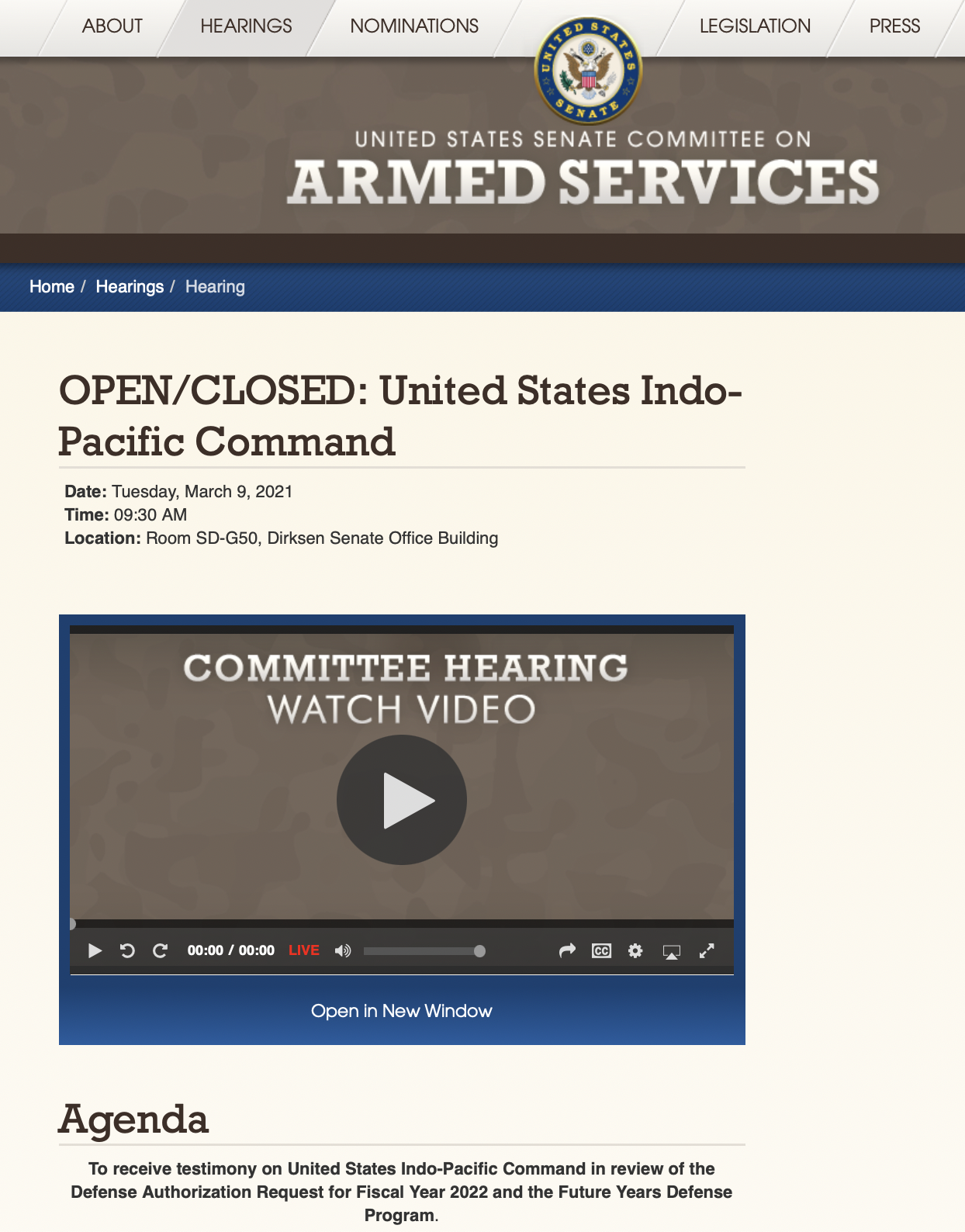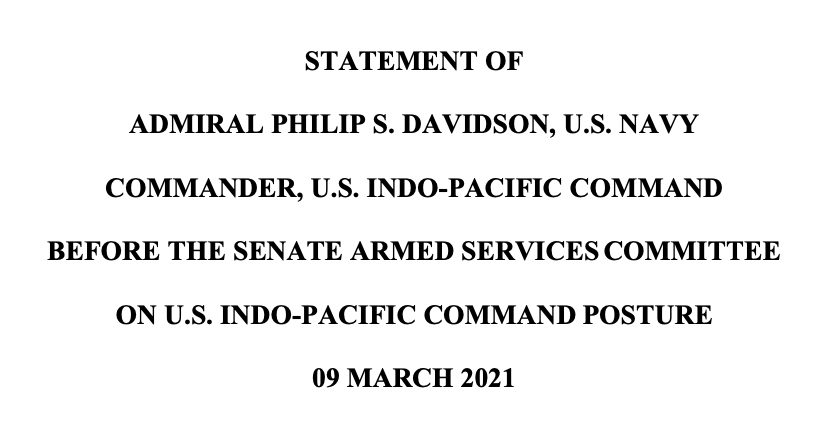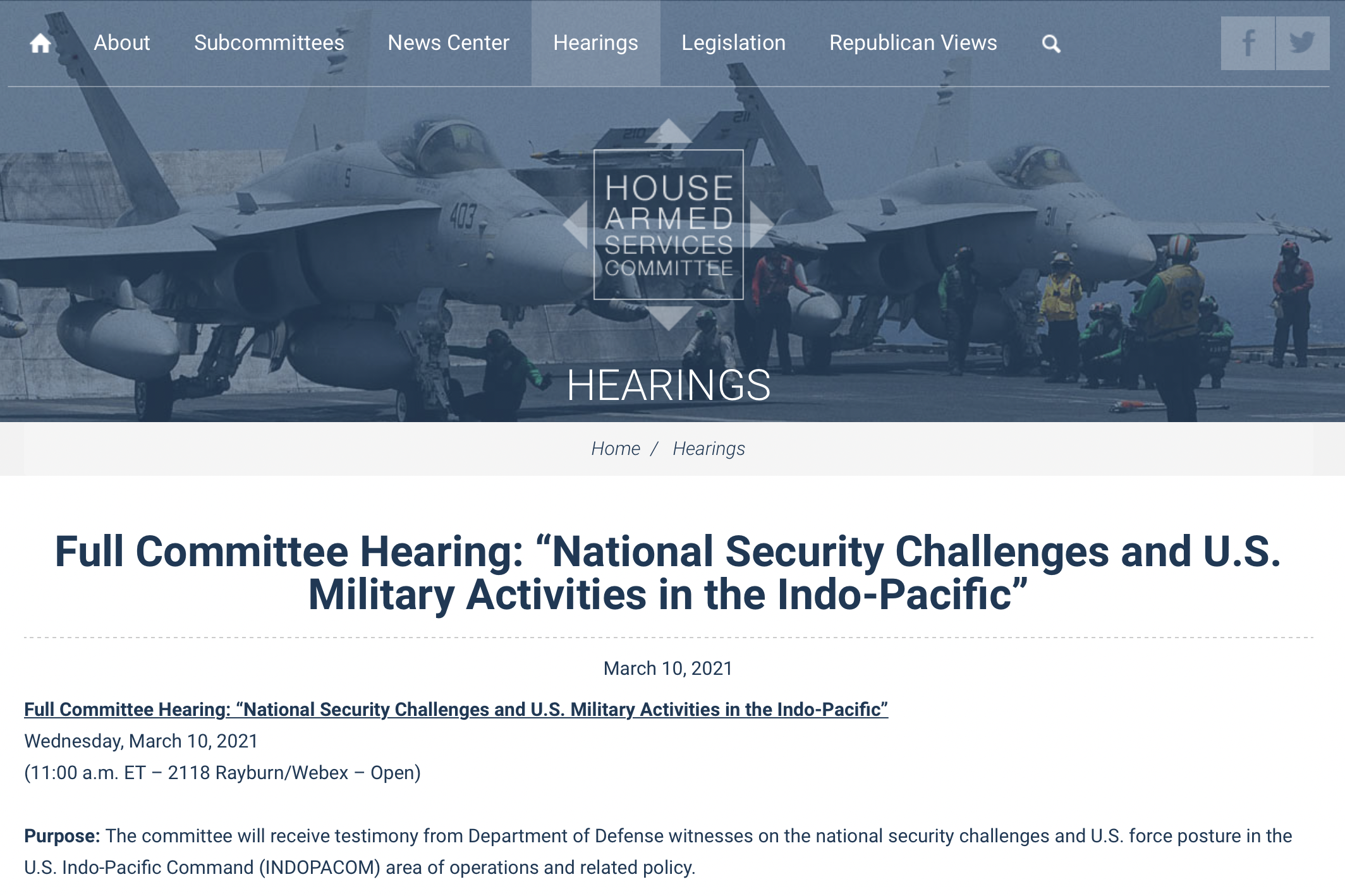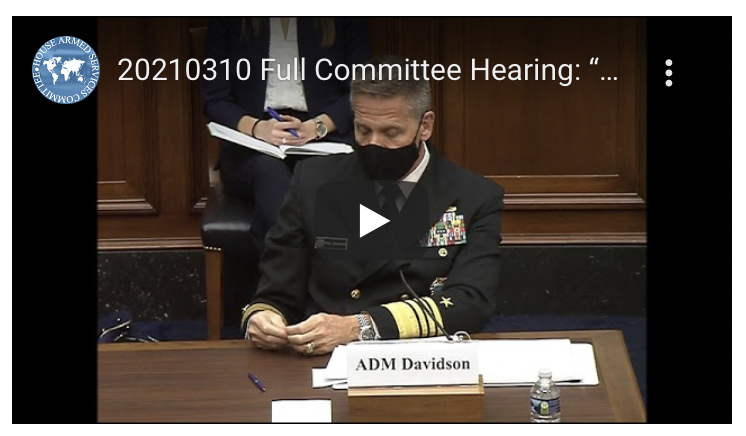Testimony by Admiral Philip S. Davidson, USN, Commander U.S. Indo-Pacific Command: “U.S. Indo-Pacific Command Posture”
Senate Armed Services Committee Hearing: United States Indo-Pacific Command
Agenda
To receive testimony on United States Indo-Pacific Command in review of the Defense Authorization Request for Fiscal Year 2022 and the Future Years Defense Program.
*There will be a closed session at 8:00a.m., immediately prior the open session, in Room SVC-217, the Office of Senate Security in the Capitol Visitor Center.
Witnesses:
Admiral Philip S. Davidson, USN
Full House Armed Services Committee Hearing: “National Security Challenges and U.S. Military Activities in the Indo-Pacific”
Wednesday, March 10, 2021
(11:00 a.m. ET – 2118 Rayburn/Webex – Open)
Purpose: The committee received testimony from Department of Defense witnesses on the national security challenges and U.S. force posture in the U.S. Indo-Pacific Command (INDOPACOM) area of operations and related policy.
Witnesses:
Mr. David F. Helvey
Acting Assistant Secretary of Defense for Indo-Pacific Affairs
Department of Defense
[STATEMENT]
Admiral Philip S. Davidson, USN
Commander
U.S. Indo-Pacific Command
[STATEMENT]
General Robert B. Abrams, USA
Commander
United Nations Command / Combined Forces Command / U.S. Forces Korea
KEY POINTS FROM ADMIRAL DAVIDSON’S STATEMENT TO BOTH COMMITTEES:
p. 2
The Indo-Pacific accounts for 60 percent of the world’s current Gross Domestic Product (GDP) and contributes more than two-thirds to the present global economic growth. Trade and investment in this dynamic region are vital to the security and prosperity of the United States and reflective in more than $1.9 trillion in two-way trade with the Association of Southeast Asian Nations (ASEAN), serving as the number one destination for U.S. foreign direct investment (FDI). In 10 years, the region will host two-thirds of the world’s population and two-thirds of the global economy. …
The greatest danger for the United States in this competition is the erosion of conventional deterrence. A combat-credible, conventional deterrent posture is necessary to prevent conflict, protect U.S. interests, and to assure our allies and partners. Absent a convincing deterrent, the People’s Republic of China (PRC) will be emboldened to take action to undermine the rules-based international order and the values represented in our vision for a Free and Open Indo-Pacific. The combination of the PRC’s military modernization program and willingness to intimidate its neighbors through the use, or threatened use of force, undermines peace, security, and prosperity in the region.
p. 3
U.S. Indo-Pacific Command’s approach for addressing Great Power Competition centers on advancing a Free and Open Indo-Pacific by focusing on four critical areas:
1. Increasing Joint Force Lethality
2. Enhancing Design and Posture
3. Strengthening Allies and Partners
4. Modernizing our Exercises, Experimentation, and Innovation Programs
In 2019, I reported to this Committee we had lost a quantitative advantage and our qualitative advantage was shrinking across several domains as the People’s Liberation Army (PLA) fields higher quality systems.
However, with this Committee’s efforts to establish the Pacific Deterrence Initiative (PDI), along with resourcing our advanced undersea warfare capabilities and 5th generation fighters, I am optimistic you have created the opportunity to Regain the Advantage, but we must remain diligent.
p. 5
Integrated Air and Missile Defense
For the past three years, I have repeatedly stated the most important action we can take to increase the joint force’s lethality is to introduce a 360-degree, persistent, air and missile defense capability on Guam (Guam Defense System (GDS)). This system and the associated architecture must be robust enough to address the emerging threats, including hypersonics and the ability to integrate existing weapon control systems within this decade.
The GDS could be established cost effectively with mature Programs of Records consisting of Aegis Baseline (B/L) 10, solid-state radar (SPY-6 or SPY-7 variant), MK-41 VLS, Aegis Ashore, and SM3/SM6. This system is critical for defending the Homeland, including our most important American operating location in the western Pacific. America’s day begins in Guam, and it is not only a location we must fight-from, but one we must also fight-for given the threats we face in the near term and the foreseeable future.
p. 9
The critical investments necessary to provide adequate dispersion to preserve deterrence options include:
- U.S. Territories. Key strategic locations to project power, deter adversaries, and respond to crises across the Indo-Pacific. Investments are focused on divert and dispersal locations as part of a distributed joint force laydown and new training facilities.
- Oceania and the Pacific Island Countries (PIC). Investments focused on alternative facilities for training and dispersion opportunities that increase airpower capacity.
- Southeast Asia. Investments focused on alternative facilities to support modernized and dispersed power projection airfields, sustain forward forces, and enhance logistics capability with prepositioned stores and infrastructure.
p. 20
- Cambodia. In early 2017, Cambodia suspended all military-to-military exercises with the United States. However, USINDOPACOM continues to cooperate in: humanitarian mine clearance actions, medical research, and MIA personnel accounting engagements through the DPAA. During these limited engagements, the command reaffirms the importance of Cambodia strengthening its democratic institutions and maintaining an independent foreign policy. In September 2020, Cambodia razed a U.S.-built facility on Ream Naval Base that served as the headquarters for the National Committee on Maritime Security, reportedly in order to make way for a PRC naval base. The United States and other countries in the region are concerned about the expansion of PRC influence in Cambodia and its implication for regional security.
p. 31
KEY ADVERSARIAL CHALLENGES
As we pursue a Free and Open Indo-Pacific, we face significant challenges from four key adversaries. The PRC represents our greatest strategic threat. Its rapidly advancing capabilities and increasingly competitive posture underscore its drive to become a regionally dominant, globally influential power. Beijing is growing increasingly confident, and PRC leaders have demonstrated a willingness to accept friction to pursue a more expansive set of political, economic, and security interests. This growing assertiveness is particularly acute concerning sovereignty disputes, as Beijing seeks to steadily and incrementally shift the regional status quo to their advantage.
p. 32
People’s Republic of China. The PRC is pursuing rapid, comprehensive military modernization across land, sea, air, space, cyber, and information domains, with a clear focus on systems intended to expand its anti- access/area denial (A2/AD) envelope across the region and enhance the country’s force projection and strategic deterrence. This far-reaching strategy aligns with the stated goals for People’s Liberation Army (PLA) modernization, which PRC leaders remain highly resolved to achieve. In October, Beijing announced it would seek to accelerate military modernization initiatives in time for the PLA’s 100th anniversary in 2027, advancing the PRC’s progress toward its previously-stated milestones of completing military modernization by 2035 and transforming the PLA into a “world-class” military by the end of 2049. The PLA is pursuing several initiatives toward this end, including developing highly capable, advanced weapons systems, enhancing its training and exercise program’s scope and complexity, and expanding the breadth of its operational space across the Region.
PLA Modernization. The PRC focuses particular attention on PLA Navy (PLAN) and PLA Air Force (PLAAF) modernization, which it sees as key to projecting power and achieving great power status. The PRC maintains the world’s largest naval force, which has tripled in size over the past two decades. The PLAN commissioned more than 25 major ships in 2020 alone, including combatants, amphibious warfare ships, and two nuclear-powered ballistic missile submarines.
The addition of these new platforms – which include two new classes of modern warships, the RENHAI guided-missile cruiser, and the LUYANG III MOD guided-missile destroyer – provides the PLAN greater maneuverability and flexibility to perform a diverse set of missions, ranging from littoral warfare to far-seas operations. Meanwhile, the PLA has operationally fielded its first 5th generation stealth fighter, the J-20. It is advancing the development of its first aerial-
p. 33
refuelable bomber, the H-6N, which will complete the country’s nuclear triad’s final leg. The PLAAF’s Y-20 heavy-lift transport aircraft also conducted its first overseas missions in 2020, advancing the PLA’s ability to quickly deploy forces and sustain operations across multiple fronts.
PLA Long Range Weapons Development. The PRC is simultaneously developing several modern, long-range weapons intended to strengthen the PLA’s standoff precision strike and nuclear deterrence and counterattack capabilities. The PRC is pursuing a range of advanced weaponry, including electromagnetic railguns, hypersonic glide vehicles, and land-attack and anti-ship supersonic cruise missiles, and the PLA Rocket Force conducts more ballistic missile live-fires every year than the rest of the world combined. The PRC is also expanding and maturing its space and counterspace programs. Beijing continues to grow its space-based intelligence, surveillance, and reconnaissance (ISR) constellation and is developing reusable launch vehicle and heavy space lift capabilities that facilitate the insertion of more and larger satellites into orbit. The PLA is also pursuing counter-space technologies such as satellite jammers and directed-energy and direct-ascent kinetic weapons. Significantly, the PRC’s Beidou-3 global satellite system reached full operational capability in June 2020, providing the PLA an indigenous system for global positioning, navigation, and timing coverage. Collectively, these developments—particularly as they reduce the PRC’s reliance on the United States’ space-based infrastructure—facilitate the militarization of space and increase the threat that the PRC will employ counter-space weapons that deny the U.S. and allied access to space during a conflict or crisis.
PLA Training and Exercises. Notably, the PRC is not merely developing advanced weapons systems but is increasingly employing them in training and exercise scenarios to hone PLA warfighting skills and send an unmistakable message to regional and global audiences. In August 2020 for example, the PRC conducted coordinated DF-21D missile launches into the South China Sea. These mid-range, anti-ship ballistic missiles are capable of attacking aircraft carriers in the western Pacific, and their employment during a large-scale PLA exercise demonstrates the PLA’s focus on countering any potential third-party intervention during a regional crisis. Likewise, the PLA conducts joint amphibious landing and maritime strike training to simulate a Taiwan invasion scenario and performs large-force maneuvers to demonstrate its ability to intervene in a Korean peninsula crisis. Through complex, realistic training and exercises that emphasize joint
p. 34
tactics and incorporate advanced technologies, the PLA continues to refine organizational and process changes initiated as part of 2015’s sweeping reforms. These reforms compensate for the lack of recent combat experience, both critical steps as the PLA prepares for modern warfare.
PRC Threats in the Region. The PRC has adopted an increasingly assertive military posture to exert pressure and expand its influence across the region. This is particularly stark concerning Taiwan. Over the past year, Beijing has pursued a coordinated campaign of diplomatic, informational, economic, and—increasingly—military tools to isolate Taipei from the international community and if necessary, compel unification with the PRC. Throughout 2020 the PLA has amplified its force posturing near and around Taiwan, to include using H-6 bombers to circumnavigate the island and conduct Taiwan Strait centerline crossings and flying military aircraft into Taiwan’s air defense identification zone (ADIZ) at the highest rate in nearly 25 years. Over the past two years, the PRC has incorporated highly-publicized amphibious assault training into national-level exercises, almost certainly to exert pressure and signal resolve.
Beijing’s authoritative messaging has also grown increasingly confrontational and has linked the PLA’s military activities near the Taiwan Strait to “separatist” activities in Taiwan. On the diplomatic front, Beijing continues to impede Taiwan’s meaningful participation in international organizations. In 2020 for example, Taiwan was blocked from participating as an observer in the annual World Health Assembly despite its success in managing the COVID pandemic. Such consistent employment of pressure tactics undermines the Chinese Communist Party claims that it desires a peaceful unification with Taiwan.
Hong Kong experienced a significant decline in autonomy following the PRC’s imposition of the Hong Kong National Security Law in June 2020. At Beijing’s behest, Hong Kong authorities used mass arrests to silence pro-democracy activists and curb further dissent by eroding the pro- democracy movement’s political power, weakening Hong Kong’s free press and promoting pro- Beijing education in Hong Kong’s schools. Meanwhile, PRC security organizations have established an official presence in the city under the auspices of the Office for Safeguarding National Security, enabling Beijing to closely monitor Hong Kong residents and enforce the National Security Law. Through these heavy-handed efforts to impose authoritarian control over
p. 35
Hong Kong affairs, the PRC has demonstrated the hollowness of its “one country, two systems” model.
The PRC’s expansionary territorial ambitions are also on display along its western border, where the PLA has been engaged in a standoff with Indian forces along the Line of Actual Control (LAC) since May 2020. The standoff was predicated by clashes over construction activities near the disputed border PLA ground maneuver and support elements subsequently forward-deployed roughly 50,000 soldiers along the LAC, leading to a counter-deployment by the Indian Army. The PLA has not yet withdrawn from several forward positions it seized following the initial clash, and the consequent escalation of tensions between the PRC and India has resulted in casualties on both sides. This large-scale PLA mobilization—which is particularly notable considering the elevation, terrain, and distance involved—has stoked regional concerns that the PRC will increasingly use force to achieve desired outcomes.
The South China Sea (SCS) situation remains unsettled in light of the PRC’s provocative behavior and expansive and unlawful maritime claims. The PRC continues to militarize the region, deploying new equipment to its artificial outposts in 2020 and using forward airfields to support a growing level of military operations by heavy transport, intelligence, and anti-submarine aircraft. The PLA also conducts large-scale exercises in the SCS with an emphasis on amphibious landing, joint fires, and maritime strike scenarios. PLA ships and aircraft maintain a consistent SCS presence and are augmented by an armada of China Coast Guard ships, fishing boats, and other para-military forces that serve as force multipliers. These actions—which are inconsistent with President Xi Jinping’s and Defense Minister Wei Fenghe’s assurances that the PRC would not militarize the SCS—threaten our allies and partners’ autonomy, jeopardize freedoms of navigation, overflight and other lawful uses of the sea, and compromise regional peace and stability.
Meanwhile, the PRC continues to use intimidation to inhibit other claimant nations’ access to offshore resources. Beijing maintains its excessive and unlawful maritime claims over a massive area in the SCS, contrary to international law as reflected in the 1982 Law of the Sea Convention. The PRC sought to further bolster its unlawful maritime claims last April, unilaterally renaming over 80 SCS geographic features and establishing two administrative districts with alleged
p. 36
jurisdiction over the region. The PRC is also attempting to solidify its claims by imposing domestic laws across the disputed waters of the SCS. In April, its Coast Guard led an eight-month campaign—dubbed “Blue Sea 2020″—that seized nearly 700 vessels for violations of PRC laws, and in early 2021, the PRC passed legislation that expanded the Coast Guard’s legal authority to use force against foreign vessels and destroy other countries’ economic structures in disputed areas. Moreover, PRC ships and aircraft continue to harass and disrupt other nations’ commercial fishing and resource exploration and extraction activities, even when conducted in areas where China cannot assert a lawful maritime claim within the respective countries’ exclusive economic zones (EEZs). The PRC’s pursuit of excessive maritime claims at the expense of neighboring states’ EEZ rights negatively affects the economies of Southeast Asian nations and threatens to weaken the effectiveness of international laws and norms.
Beijing similarly seeks to advance its territorial ambitions in the East China Sea (ECS), and consistently uses its Air Force, Navy, and Coast Guard to press its sovereignty claims vis-à-vis the Japanese-administered Senkaku Islands, test Japanese and U.S. resolve, and ratchet up tensions in Northeast Asia. China Coast Guard vessels routinely enter the territorial waters of the Senkaku Islands to assert PRC sovereignty, despite lacking international standing on the dispute. PRC ships conducted presence operations in the contiguous waters around the Senkakus for a record 333 days in 2020, an increase of nearly 20% from 2019. In a reprise of its earlier SCS maneuvering, in June 2020, Beijing unilaterally renamed 50 geographic features in the East China Sea, a number of which are near the Senkaku Islands. The PRC’s simultaneous employment of military and administrative measures to pursue its ECS claims is indicative of its broader efforts to steadily and incrementally shift the regional status quo in Beijing’s favor. Beijing is increasingly using all instruments of national power to fundamentally remake the rules-based international order into one more aligned with, and amenable to, the PRC. Its signature “One Belt, One Road” (OBOR) strategy, is predicated on building a global economic system thatenforces PRC preferences and ideologies while eschewing transparency and internationally- accepted investment practices. Beijing utilizes loans, grants, and monetary gifts to establish economic dependence, corruptly capture elite allegiance, and in some cases, consolidate control. The PRC also leverages OBOR projects and economic pressure as part of a broader strategy to develop overseas PLA bases and support facilities; the naval base currently under redevelopment at Ream, Cambodia, is the latest example of the PRC’s global basing ambitions.
p. 37
To foster a Free and Open Indo-Pacific, the United States, alongside our allies and partners, must stand up to Beijing’s coercive economic strategies while providing viable assistance and alternatives to borrowing countries.
p. 41
CONCLUSIONS AND IMPLICATIONS
The greatest danger for the United States is the erosion of conventional deterrence. Without a valid and convincing conventional deterrent, the PRC will be emboldened to take action in the region to supplant U.S. interests. As the military balance in the Indo-Pacific becomes more unfavorable to the United States, we are accumulating additional risk that may embolden our adversaries and competitors to attempt unilaterally changing the status quo.
USINDOPACOM’s focus is to ensure access, freedom of maneuver, and our ability to project power in the shared domains, which enables USINDOPACOM to deter and deny our adversaries’ and competitors’ ability to engage in acts of aggression, coercion, or other malign behavior towards our allies and partners along the First Island Chain. Ultimately, the steps we take must convince our adversaries and competitors they simply cannot achieve their objectives with force.
PDI provides a pragmatic and economically viable approach for implementing a deterrence strategy for defending U.S interests in the Indo-Pacific while mitigating risk and avoiding escalation. Funding levels in PDI for FY21 equates to seven-tenths of 1% of the DOD’s Total Obligating Authority in FY21, and just two-thirds the amount spent on the European Defense Initiative in FY20 ($5.9B).
USINDOPACOM must field an integrated Joint Force with precision-strike networks along the First and Second Island Chains; an integrated air and missile defense in the Second Island Chain; and an enhanced force posture that provides the ability to preserve regional stability, and if needed, disperse and sustain combat operations for extended periods.









































